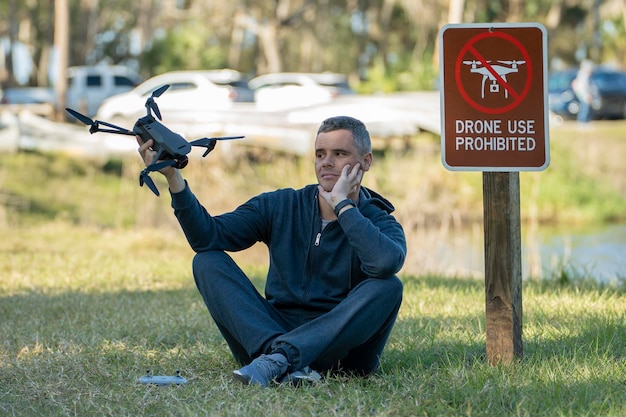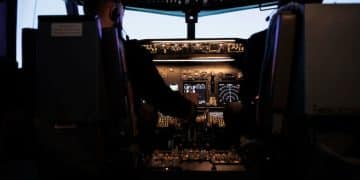UAS Regulations Update: What Drone Pilots Need to Know in 2024

New regulations for Unmanned Aircraft Systems (UAS), effective in 2024, bring significant changes impacting drone pilots, including remote ID requirements, operational restrictions, and updated certification processes to ensure safer and more responsible drone operations across the United States.
The landscape of drone aviation is constantly evolving, and with 2024 comes a fresh set of regulations for Unmanned Aircraft Systems (UAS). It’s vital for every drone pilot, whether hobbyist or professional, to stay informed and compliant. This article breaks down everything you need to know about the new regulations for Unmanned Aircraft Systems (UAS) Take Effect: What You Need to Know, ensuring you’re ready for takeoff.
Understanding the Remote ID Mandate for UAS
One of the most significant changes is the full implementation of Remote ID. This technology allows drones to be identified in flight, providing location information to aviation authorities, law enforcement, and other authorized parties.
Remote ID is crucial for integrating drones safely into the national airspace system, reducing the risk of interference with manned aircraft and addressing security concerns. Let’s delve into the specifics of this mandate.
What is Remote ID?
Remote ID is essentially a digital license plate for drones. It broadcasts the drone’s identity, location, altitude, and control station location in real-time.
Compliance Options
Drone operators have several options for complying with the Remote ID mandate:
- Standard Remote ID drones: These drones have Remote ID built-in and broadcast the required information directly from the drone.
- Broadcast Module: If your drone doesn’t have built-in Remote ID, you can attach a broadcast module, also known as a Remote ID drone.
- FAA-Recognized Identification Areas (FRIAs): Fly in designated areas where Remote ID is not required: these are typically managed through community based organiztions.

The Remote ID mandate aims to enhance accountability and transparency in drone operations, ultimately fostering a safer and more secure airspace.
Changes to Operational Restrictions for Drones
Beyond Remote ID, the new regulations introduce several changes to operational restrictions. These updates affect where and how you can fly your drone, ensuring responsible use of airspace alongside manned aircraft and other UAS.
These operational rules are designed to mitigate risks and maintain the safety of both drone operations and the surrounding environment.
Flying Over People
The updated rules expand the ability to fly drones over people, depending on the drone’s weight and level of certification. These changes are designed to allow some operations with less risk to be executed with few restrictions, while still maintaining some risks on more potentially dangerous operations.
Night Operations
Night operations are now permitted under Part 107, provided the drone has anti-collision lighting. This change opens up new possibilities for commercial drone activities.
- Ensure your drone is equipped with functional anti-collision lights visible from at least three statute miles.
- Maintain visual line of sight with the drone at all times during night operations.
- Be extra vigilant about potential hazards, such as obstacles and other air traffic, which may be harder to spot in the dark.
These changes to operational restrictions are designed to strike a balance between enabling innovation and maintaining safety in the skies.
Updates to Pilot Certification and Training
To ensure that drone pilots are well-prepared to operate under the new regulations, updates have been made to pilot certification and training requirements. These changes aim to enhance knowledge and skills, promoting safer and more responsible drone operations.
Proper training and certification are essential for minimizing risks and maximizing the benefits of drone technology.

Part 107 Knowledge Test
The Part 107 knowledge test has been updated to reflect the new regulations. Aspiring commercial drone pilots will need to pass this test to obtain their Remote Pilot Certificate.
Recurrent Training
Remote pilots are required to complete recurrent training every two years to stay current with regulations and best practices. This training ensures that pilots remain knowledgeable and proficient in their skills, adhering to updated safety standards.
By continually enhancing pilot certification and training, the aviation community aims to ensure that drone operations are conducted safely and responsibly.
Integrating UAS Safely into the National Airspace
One of the key goals of the new regulations is to integrate UAS safely into the national airspace system. This complex task requires careful planning, coordination, and adherence to established procedures.
Safe integration of drones into the airspace is essential for realizing the full potential of this technology while minimizing risks to manned aircraft and the public.
Airspace Awareness
Drone pilots must be aware of airspace classifications, restrictions, and Temporary Flight Restrictions (TFRs). Understanding airspace is critical for avoiding conflicts with manned aircraft and ensuring safe operations.
Communication and Coordination
Effective communication and coordination with air traffic control (ATC) and other airspace users are essential for safe integration. Drone pilots should follow established procedures for requesting airspace access and reporting any unusual occurrences.
- Always check for Temporary Flight Restrictions (TFRs) before each flight using official FAA resources.
- Maintain constant situational awareness and be prepared to react to unexpected events.
- Report any potential hazards or safety concerns to the appropriate authorities promptly.
By integrating UAS safely into the national airspace, the aviation community can unlock new opportunities while preserving the safety and efficiency of the existing system.
The Impact on Commercial Drone Operations
The new regulations will have a significant impact on commercial drone operations, potentially opening new doors for various industries. Understanding these changes is crucial for businesses looking to leverage drone technology for their operations.
The updated rules create opportunities for efficiency, innovation, and growth across a wide range of sectors.
Opportunities for Growth
With expanded permissions for flying over people and night operations, commercial drone operators can now offer services that were previously restricted and expand revenue opportunities.
Operational Efficiencies
The new regulations can also lead to greater operational efficiencies for businesses that use drones. Streamlined processes and increased flexibility can reduce costs and improve productivity.
By adapting to the new regulatory landscape, commercial drone operators can unlock new opportunities and drive innovation in their respective industries.
Future Trends in UAS Regulations
As drone technology continues to evolve, it is important to anticipate future trends in UAS regulations. Staying ahead of these changes will help drone pilots and businesses prepare for what lies ahead.
The regulatory environment is dynamic, and ongoing developments are likely to shape the future of drone operations.
Advanced Operations
Future regulations may focus on enabling advanced operations such as beyond visual line of sight (BVLOS) flights and autonomous operations. These capabilities could unlock new possibilities for drone applications in various sectors.
Automation and Integration
Increased automation and integration with air traffic management systems are also likely to be key trends. These developments could streamline drone operations and enhance safety.
- Continue monitoring regulatory updates and announcements from the FAA.
- Engage with industry associations and stakeholders to stay informed about emerging trends.
- Invest in training and technology that will enable you to adapt to future regulatory requirements.
By closely monitoring future trends in UAS regulations, drone pilots and businesses can position themselves for success in the evolving landscape of drone aviation.
| Key Point | Brief Description |
|---|---|
| 🔑 Remote ID Mandate: | Requires drones to broadcast identification and location information. |
| 🌃 Night Operations: | Permitted with anti-collision lighting and adherence to safety guidelines. |
| 🧑🎓 Pilot Certification: | Updated Part 107 knowledge test and recurrent training requirements. |
| 🏢 Commercial Impact: | Expands opportunities and efficiencies for various industries. |
Frequently Asked Questions (FAQ)
▼
Remote ID is like a digital license plate for drones, broadcasting identification and location during flight. It’s important for integrating drones safely into the airspace, addressing security concerns and ensuring accountability.
▼
Yes, night operations are now permitted under Part 107, provided your drone is equipped with anti-collision lighting. Always maintain visual line of sight and stay vigilant about potential hazards.
▼
You can comply by using a drone with built-in Remote ID, attaching a broadcast module to your drone, or flying within FAA-Recognized Identification Areas where Remote ID is not required.
▼
Failure to comply with the new regulations can result in penalties, including fines and suspension or revocation of your Remote Pilot Certificate. Ensure you are fully informed and compliant.
▼
The latest information on UAS regulations can be found on the FAA’s website, through industry associations, and by attending webinars and workshops focused on drone operations and compliance.
Conclusion
Staying informed about the new regulations for Unmanned Aircraft Systems (UAS) Take Effect: What You Need to Know is crucial for every drone pilot. By understanding and complying with these regulations, you can contribute to safer skies and unlock new opportunities in the world of drone aviation.





